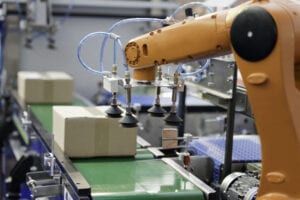 According to Fortune Business Insights, the global conveying systems market size is projected to grow from $5.2 Billion USD in 2019 to $7.4 Billion USD by 2027. This represents a 4.5% CAGR over the forecast period. OEMs who successfully design and build the machines that fuel this expansion will require a deeper understanding of how the logistics industry and conveying equipment systems are impacted by trends such as digitization and the global pandemic.
According to Fortune Business Insights, the global conveying systems market size is projected to grow from $5.2 Billion USD in 2019 to $7.4 Billion USD by 2027. This represents a 4.5% CAGR over the forecast period. OEMs who successfully design and build the machines that fuel this expansion will require a deeper understanding of how the logistics industry and conveying equipment systems are impacted by trends such as digitization and the global pandemic.
The pandemic has affected millions of lives and disrupted “business as usual” for thousands of logistics organizations across the globe. As distribution centers scramble to increase agility and resilience, while navigating unorthodox working conditions and unpredictable supply chains, a new mentality for remaining in business has emerged: accelerate the push to digitization.
In fact, a recent McKinsey Global Survey of executives revealed that their organizations “have accelerated the digitization of their customer and supply-chain interactions and of their internal operations by three to four years.”
Why? The ability to automate picking, sorting, and conveying operations to better accommodate sudden demand has proven a godsend to organizations in the vortex of pandemic-driven marketplace changes. Senior management teams also recognize that COVID-19 will not be our last crisis. Supply chains that are agile enough to weather both unanticipated crises and fast-changing marketplace conditions will now serve as an important competitive differentiator moving forward.
Modern conveying equipment reduces process lead-time and labor costs
For many logistics organizations, a key goal is full material handling automation and product movement. Process automation of order entry, warehouse and distribution facility inbound and outbound traffic of goods, robotics deployment, and shipment tracking are all considered key stepping stones towards digitization of these businesses. To accomplish these transformations, logistics organizations are counting on their OEMs to develop automation solutions that result in substantial process efficiency improvements.
This new world of logistics, robotic solutions, and more open automation systems will create additional opportunities for high-value engineering. Until now, traditional conveying equipment systems required a series of high volume, repetitive, manual programming tasks, in order to enable interoperability between heterogeneous subsystems. Under these circumstances, logistics firms were hesitant to pay high rates for work that failed to add any real value. End users are also more likely to avoid upgrading their systems because of concerns over high cost, time, and risk.
New software-driven automation engineering, however, adds value to the integration process by drastically minimizing manual, low-value engineering steps. Traditional barriers can be overcome by promoting software-centric and asset-centric automation, by active wrap and reuse of existing systems, and by introducing a new generation of “plug and produce” portable and interoperable solutions that are far less costly to implement. These solutions optimize IT/OT convergence and set the stage for self-configuring, self-healing and faster retooling systems that drive speed and agility.
Evidence of early successes can be found in vast warehouses near major towns, manned by expansive networks of conveyors, or armies of robots that pick products from thousands of bins and assemble those products into a secure, ready-for-delivery package. Such warehouses are justified and cost-effective because the need for manual labor has been significantly curtailed, while the distance between consumers and their products has been shortened.
Digitized pick-and-place solutions drive OEM and end user efficiencies
As logistics firms seek to accelerate their operations through the deployment of digitized conveying equipment systems, the fully articulated legacy robots they have in place are imposing work cycle speed limits. This is why conveying equipment system manufacturers, like Schneider Electric, are more focused on providing the components necessary for deploying modern pick-and-place solutions. Technologies such as delta robots (parallel robots that consist of three arms connected to universal joints at the base), cartesian robots (an industrial robot whose three principal axes of control are linear and are at right angles to each other), and SCARA robots (for pick-and-place or assembly operations where high speed and high accuracy is required) address these current needs of faster speed and higher accuracy. By working with OEMs to integrate the drive, controller, and mechanical and motor parts of these robots into the larger conveyance machines, our experts help OEMs to reduce time-to-market and end users find themselves with more agile, adaptable solutions.
For more information
Recognizing trends and injecting material handling innovation into the conveying equipment machine design and delivery processes are important steps for achieving competitive advantage and business growth. To learn more about how digitization is impacting OEM machine development in the logistics industry, download our e-guide “Agile OEM Approaches for Logistics Conveying and Sortation Systems.”



